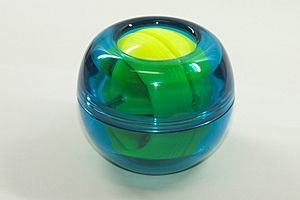Gyroscopic exercise tool facts for kids
A gyroscopic exercise tool is a cool device that helps you make your wrist, forearm, and fingers stronger. It's often used in physical therapy to help people recover from injuries. It's also a fun toy that shows off some amazing ideas from physics about how things spin.
This tool is usually about the size of a tennis ball. It has a plastic or metal outer shell, and inside, there's a heavy mass that spins freely. You start it by pulling a short string, like starting a toy top. Once the gyroscope inside is spinning fast enough, you can make it go even faster! You do this by moving your wrist in a circular motion while holding the device. It's pretty neat to feel the power as it speeds up!
How It Works
This device works because of some clever physics. Inside the outer shell, there's a spinning weight. This weight is attached to a thin metal rod, called an axle. The ends of this axle sit in a special circular groove inside the shell. A light ring also sits in this groove, helping to keep the spinning weight centered so it doesn't rub against the shell and slow down.
To make the spinning weight go faster, you need to apply a force that helps it speed up. This happens because of friction between the axle and the groove. When you tilt the shell by moving your wrist, you create a turning force, called a torque, on the axle. This torque makes the axle ends shift along the groove.
This shifting motion, called precession, is key. As the axle shifts, the friction between it and the groove actually helps to speed up the spinning weight. It might seem strange that friction can make something go faster, but in this special case, it does! Imagine pushing a bowling ball across the floor; friction helps it start spinning. Here, your wrist movement provides the energy, and the friction converts some of that energy into faster spinning of the gyroscope.
The cool thing is that you don't have to be super precise with your wrist movements. The device is designed so that as long as you apply enough turning force, the spinning weight will speed up. This makes it easy for almost anyone to learn how to use it in just a few minutes. Just remember, the groove inside must not be slippery, because friction is what makes it work!


